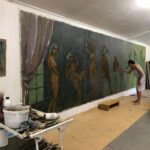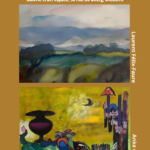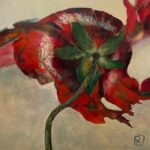Nadine Nacinovic, a Symphony of Colours
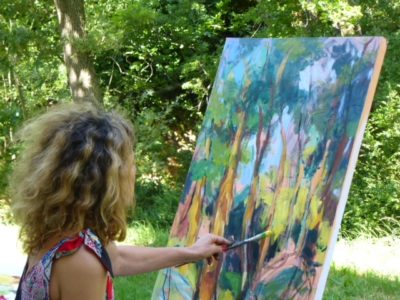
SALETTES
The landscape around Salettes in the Drôme Provençale is quite exceptional. A wild rocky escarpment culminating on one side with a long row of vertical craggy cliffs that rise to 550 metres forming a spectacular backdrop to the village that only takes the time of a sigh to cross.
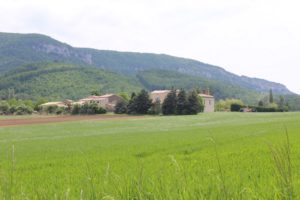
There is a nondescript little church that the local authorities for lack of better have classified as half modern (sic), a few stone houses and a development with recently built villas that could do with a bit more greenery. But the countryside that spreads out on the other side of the village is bucolic and beautiful with gentle glowing hills patterned by cultures and dotted by old farmhouses before it evens out into a wide open plain, fringed by distant mountains. A dreamlike setting for painters, and in summer, here and there, small groups can be seen assiduously at work behind their easels. There is a fair chance they are accompanied by Nadine Nacinovic to guide them for she knows every nook and cranny of the region and has painted them a thousand times over. She lives a stone’s throw from Salettes at “La Ferme des Dames,” an old farmstead where she has set up her studio.
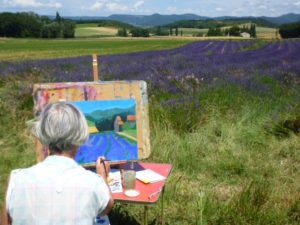 Nadine was born in Nice on the Côte d’Azur where she grew up absorbing all the light and the bright colours of the sunny south of France. Her genes are also Mediterranean for her father came from Croatia and her mother was an Italian and this might well be an added explanation for her outgoing personality as well as the choice of a brightly coloured pallet so characteristic of her paintings. “She speaks with her brush strokes” someone once remarked. This is obvious when listening to the enthusiastic way Nadine talks about art and generously describes the work of her fellow painters. She has a thirst for art and knowledge about art which leads her to go to as many exhibitions as she can and visit museums as well as communicating with people involved in the art field. As a young girl this led her to work at the Picasso Museum at Antibes and at the Renoir Museum in Cagnes-sur-mer. Contrary to many artists who tend to be completely absorbed by their own work Nadine is outgoing and genuinely interested in others, with whom she loves to exchange ideas and talk shop.
Nadine was born in Nice on the Côte d’Azur where she grew up absorbing all the light and the bright colours of the sunny south of France. Her genes are also Mediterranean for her father came from Croatia and her mother was an Italian and this might well be an added explanation for her outgoing personality as well as the choice of a brightly coloured pallet so characteristic of her paintings. “She speaks with her brush strokes” someone once remarked. This is obvious when listening to the enthusiastic way Nadine talks about art and generously describes the work of her fellow painters. She has a thirst for art and knowledge about art which leads her to go to as many exhibitions as she can and visit museums as well as communicating with people involved in the art field. As a young girl this led her to work at the Picasso Museum at Antibes and at the Renoir Museum in Cagnes-sur-mer. Contrary to many artists who tend to be completely absorbed by their own work Nadine is outgoing and genuinely interested in others, with whom she loves to exchange ideas and talk shop.
There is energy in Nadine’s work and so much zest for life that it is hard not to conclude that producing art is an extension of herself and that life without the ability or desire to paint is something she cannot imagine. It is also an activity she wishes to share. Besides her many successful exhibitions Nadine gives courses and organises workshops. For many years her weekly life drawing sessions were extremely popular and during the summer season her outdoor painting courses continue to be attended by enthusiastic amateurs and professionals – some of them regularly coming from abroad. As though this is not enough Nadine has specialised in art therapy and regularly helps groups of mentally disabled persons to express their feelings and find solace in art.
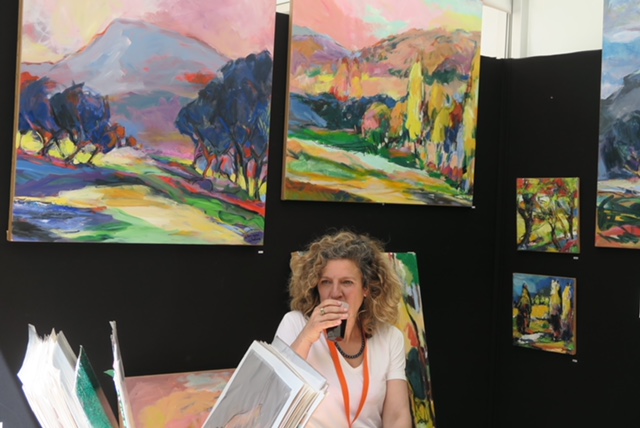
Nadine Nacinivic is an artist well worth meeting and her vividly coloured paintings will appeal to many. She invites people who are interested to visit her studio at the “Ferme des Dames,” 26160 Salettes.
***
Nadine kindly accepted to talk to me about her background, informally answering my questions in her own words and in no particular order.
A LIFE STORY DEDICATED TO ART
As a little girl can you remember when you first started to draw and if so what did you draw?
Yes, I can remember the moment when I started to draw very well. I lived at Villeneuve Loubet on the Côte d’Azur in a house that my parents built. We lived with two other Croatian families, my uncle and aunt, and my cousins. The house was perched on a small hillside and to get there you had to climb a steep outdoor staircase next to which there was a maritime pine with a very tall trunk. Every morning when I woke up there was a squirrel that seemed to have adopted the tree. For me it had become a daily rendezvous. Through the window of my bedroom I looked out on the forest where I used to build huts. My first drawings -they were always the same one – I could still make them today: on the right hand side of the paper there were rocks in front of which a spring flowed and behind it on the left side a big tree with a squirrel. Those were my first drawings, always the same subject. My primary school teacher liked them and asked me whether she could frame one and hang it on the wall of the school hallway.
I also remember whole afternoons in my room making abstract paintings with lots of different materials, pasting candle wax, torn off pieces of newspaper, etc. I felt completely free to express myself as I wished. I had never visited a museum nor been to a cinema. My parents were immigrants, my father was Croatian, and my mother came from Tuscany, and our only pastimes were parties with friends at home. I remember two faces I painted inspired by Modigliani and for which I applied melted candle wax, sculpting it while it was still hot so that the eyes had more expression in them. When I was 18 I exhibited two paintings for the first time at a cultural centre at Cagnes-sur-mer. My mother who liked them very much hung them in the living room where they still are today. They are not particularly joyful but they do have a presence.
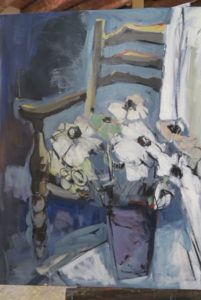
Do you come from an artistic family?
No, my family is not artistic but my parents are in part responsible for my creativity, my passion for landscape painting and for a basic aspiration for harmony that are all part of who I am. My mother as I have already said comes from Tuscany, her whole family lives in the heart of the Chianti region: Castellina in Chianti, San Gemignano, colle val d’Elsa. My Italian grandparents own a very large farm with a splendid view from the kitchen window overlooking colle val d’Elsa and San Gemignano with its towers through the window on the other side.
The path lined with Cypress trees that go up to “Collina”, a hillside that belongs to my grandparents, does not stop twisting and turning and it is covered by a layer of thin dust that whirls up in the air and blankets the Cypress trees in white. On reaching the top I used to be dazzled by what I saw below, the vineyards, the fruit and olive trees, the vegetable garden, the animals, the pigs and chickens. I could also spot the hammock and Angelo the hunchback who had been taken in by my grandparents and lived at their place. It was all pure beauty and harmony!
I don’t remember ever having visited a museum when I was young. We led a simple life, mother worked as a charwoman, father was a mason but thanks to them I discovered beautiful sites and landscapes, unfortunately overrun by tourists today.
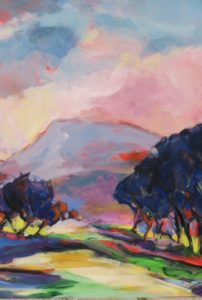
My Croatian father had fled Tito’s regime and arrived in France “with only his pants to wear” he used to say, not knowing anybody and not speaking the language. On the rare occasions I travelled to Croatia with my parents we went to visit our family. We would stay a few days, visit one or two members of the family and some of the sites like the area of Pula or the village of Porec, where I went to last summer. I realise today how fortunate I was as a child to have seen so many harmonious landscapes: the beautiful country side of Tuscany, the Croatian coast and the sun baked Côte d’Azur, where I grew up. We lived at Villeneuve Loubet from where we had a unique view of the castle of Villeneuve and I was left completely free to roam the fields and woods. I can’t tell you how happy I was as a child when I explored my surroundings and went on foot to the village that was at some distance away. I can still remember the smell and the quality of the earth, the odours of the vegetation, the texture of the lichen and how I used to walk along narrow pathways. I can still picture it all very clearly in my mind.
When did you decide to register at the Beaux-arts of Lyon?
I was still very young when I began to paint pictures in my room but I don’t know when it really began. Later I had to decide on what I planned to do in the future and as I was good at drawing I automatically wanted to pursue an artistic vein and opted for an arts and history of art baccalaureate at school. It is when I discovered the history of painting that my passion was born. Following matriculation, came the question of what next? I had never discussed my future with my parents, they were ignorant of the options that were open to me; my brother studied engineering proving that it was possible for the son of a workman and an immigrant to be successful. With hindsight, I am grateful that my parents gave me the freedom to make my own choices for the future.
When I was at school in Nice my friendship with Armelle played a decisive role in making my choice for the future. Together we visited all the museums of the Côte d’Azur. She was just as passionate as I was and she became my main initiator in art. Between midday and two o’clock and when there were no classes, we would go out together in the footsteps of the great painters who had lived and worked between Nice and Antibes; even today it moves me when I recall these outings! When I was 18 years old I worked at the Renoir museum “aux Colettes” as a guide and interpreter; it is a wonderful place where I felt completely at home. I used to pluck figs in the garden and dry them on the large terrace of the studio where the models used to pose for Renoir. In those days the museum had not yet been renovated and it still had an authentic atmosphere of bygone days. Afterwards, when I was 19 I obtained a work placement at my favourite museum, the Picasso museum in Antibes. Danièle Giraudy who was the curator at the time asked me to conduct workshops for children; just imagine how nervous I was for I had never done anything like it before. Daniel Meurisse exhibited figurative paintings in the museum, enormous blue coloured leaves that served as a subject for my workshops. I would spread out huge plastic tarpaulins in order to prevent the paint from making spots on the floor. The space has now become the museum library. One day large wooden crates arrived plastered with labels. They contained paintings by an American artist called Françoise Gilot. Later I heard that she had been Picasso’s wife and that she had resided in what had now become the museum. I also held an exhibition at the Château Musée de Cagnes-sur-mer and on that occasion I was awarded the painting prize for young talents, and that of course filled me with tremendous pride.

With my BAC in my pocket I had no wish to go to the Beaux-arts of Nice for there was still a lot for me to discover. I told myself that if the Côte d’Azur had such a rich and eventful past, Paris with all its museums, it’s exciting cultural life must have much more to offer. I attempted two entrance exams for the Paris Beaux-arts, but unfortunately failed. So I opted for Lyon which is the second largest city of France. The students at the Beaux-arts of Lyon enjoyed a lot of liberty, too much as far as I was concerned and I was disappointed for when I registered I wanted to learn and acquire more knowledge and culture. So I decided to do what I have always done – and continue to do – and that is set up what does not yet exist. That was also the time of my encounter with two other students who would become lifelong bosom friends. We called ourselves “les Abeilles” (the Bees), a group of three girls who shared the same conception of figurative art, the same quest for beauty and the desire to give sense to their paintings through the use of colour. The name “les Abeilles” is a reference to the “Ruche” (beehive) in Montparnasse in Paris, where so many great painters from all over Europe had lived and worked.
For us to be “les Abeilles” meant 20 adventurous and creative years, with exhibitions, performances (many of them in the Drôme) and other artistic events such as life paintings. We used to paint ourselves from head to toe, compose our own music and mix dance, music and visual representations. This avant-garde conceptual art form of ours met with considerable success and it became very popular. At a later stage “les Abeilles” gave birth to the BIZZ-ART in Souspierre, in which I was heavily involved (the Secretariat was at my home, “la Ferme des Dames” that for many years was became a buzzing beehive!)
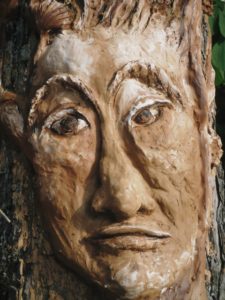
At the School of Fine Arts they teach you all kinds of things, tricks of the trade as someone once called them! To what extent has what you learned there been useful and if so why, and when did you start to develop your own style?
I was disappointed by the Beaux-arts in Lyon. In those days there was a lot of talk about minimalism whereas my style is a highly coloured form of figurative art which is the exact opposite. For 6 years my teachers did everything they could to make life difficult for me and get me to give up figurative work and colour. Of course I did make installations, etc. but to no avail. My painting is in line with those artists for whom a paint brush, colours and canvas are the tools, in short, my style favours the classic approach.
My disappointment however did lead to something positive and adventurous which was “les Abeilles” the meeting of the three women artists already mentioned who shared the same ideas and convictions. The group was extremely active in and around Lyon. People knew who we were and called us “les Abeilles.” It was a wonderful time during which I led a bohemian life, working as an artist’s model, giving drawing and painting lessons, pursuing my studies at “les Beaux-arts” and sleeping in rundown buildings. Life was real and full of promise!
What is the significance of art for you and could you live without it?
Art is a form of meditation, of poetry. It is just as indispensable for me as music. When I visit a museum time stops, I forget it is passing, I become an integral part of the present. Thanks to art I am in tune with myself, I am more human and aware of the beauty of things around me. All this doesn’t mean that my painting is complacent but rather that I strive to paint the good things of life those that give energy.
On a more personal note. You are a very sensitive person that allows emotions to pass without any form of protection. That can hurt and it could make you cautious. But your paintings are full of fire and colour. A painter, I can’t remember his name, once said that what you paint is yourself. In your case I see generosity and an enormous zest for life. Am I right?
My paintings have changed in the course of time and so have my colours. When I paint I’m driven to be myself at all costs. My brush technique is large and ample and my greatest joy is to work with colour. Ahem, to mix colours what a joy!
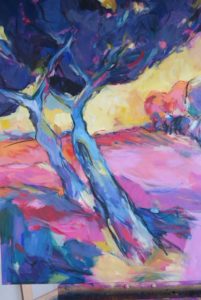
How do you go about your work. Do you use a sketchbook or do you paint straight onto the canvas? Do you prepare the canvas in advance (Gesso, colour layer…) Do you prefer oils or acrylics? And what about watercolours?
I don’t have a fixed method when I paint. I am guided by my emotions, by what I see, and then I decide how to tackle the painting, the kind of structure it requires and the colour. I mainly paint my surroundings. The landscape all around me is beautiful, why look for something that is already there? The weather and the seasons determine the different shades of colour, the forms and the light that must go into the painting. I will not stop until I am satisfied with the work.
Since leaving Lyon what do your activities consist of?
I met my future husband when I was in Lyon where I lived for 6 years. He came from la Drôme which was the reason we settled here and that, besides the continuation of “les Abeilles,” was the beginning of a new adventure ; Soon after I arrived I began by holding weekly life drawing sessions at my studio in “La Ferme des Dames”* as well as organising workshops on different themes at regular intervals. During the summer season I organise outdoor landscape painting courses that draw amateurs as well as professionals, some of whom come from abroad. And of course I never stop painting. In conclusion, my life in the Drôme is full and active and it is mainly centred on ART!
*Dames stands for the nuns who lived and worked in this large farm with a lot of land up until 1954.
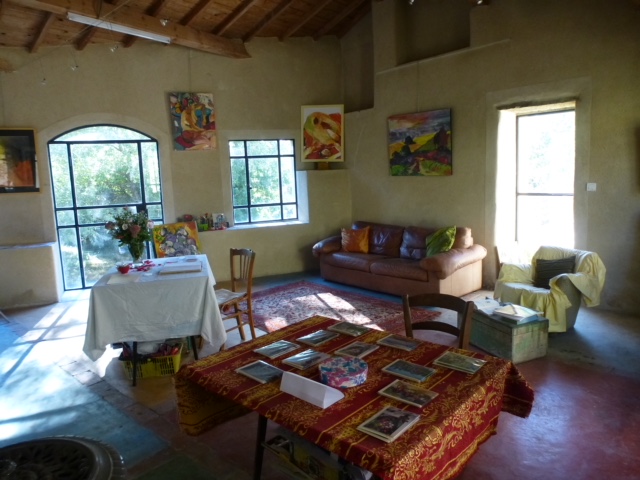
PLEASE NOTE
Nadine will organize 3 summer landscape painting courses in the Drôme Provençale:
– Friday 20, Saturday 21 and Sunday 22 July 2018
– Friday 3, Saturday 4 and Sunday 5 August 2018
– Friday 21, Saturday 22 and Sunday 23 September 2018
For more information, email Nadine
Website Nadine Nacinovic
Video (in French): Atelier d’art thérapie au Foyer d’Accueil Médicalisé du Poet-Laval
Video (in French): Journées du patrimoine 18-19-20 septembre 2015
Book by Nadine Nacinovic
